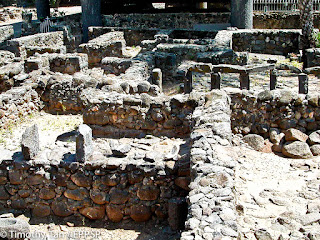Israel, Capernaum - 4th Century Synagogue
Traveling to places of historical significance has always been a favourite travel itinerary for me. These trips allow me to visit in person the locations of places I read about in the history books.
Amongst the many historical places I had visited, one of my favourite has to be Capernaum.
History and Geography
Frequently cited in the Gospels, Capernaum is located on the shores to the north of the Sea of Galilee in Israel. Reportedly inhabited since the 2nd century BCE, the town was abandoned in the 11th century.
Capernaum was originally a small fishing village, probably because of its close geographical proximity to the Sea of Galilee. The Sea of Galilee, also known as Lake Tiberius, is the largest freshwater lake in Israel. It has an area that is approximately 167 square kilometres (about 65 square miles).
Climate
History and Geography
Frequently cited in the Gospels, Capernaum is located on the shores to the north of the Sea of Galilee in Israel. Reportedly inhabited since the 2nd century BCE, the town was abandoned in the 11th century.
Capernaum was originally a small fishing village, probably because of its close geographical proximity to the Sea of Galilee. The Sea of Galilee, also known as Lake Tiberius, is the largest freshwater lake in Israel. It has an area that is approximately 167 square kilometres (about 65 square miles).
Climate
The weather in Capernaum is typical of the weather throughout Israel. The coldest months are between December to March when the daily average temperature usually hovers around 20 deg C. This is the best time to visit.
The hottest months are between July and August when the daily temperatures can reach as high as 38 deg C.
Getting There
Driving or charted transports are the available options to get to Capernaum.
I recommend for first-time visitors to join a day-tour where you will not only get to visit Capernaum but also the surrounding regions. Other popular places on the itineraries of some day-tours may also include a visit to Caesarea on the coast of the Mediterranean Sea.
What to Expect
Today, one of the most significant ruins of this ancient site is a 4th century synagogue, considered to be amongst the oldest in the world.
Standing out in the historical site, the synagogue's elaborately carved white stones contrasted with the darker-colored basalt materials used for the surrounding buildings. This 4th century synagogue is supposedly built upon the foundations of an even earlier synagogue that dates back to the 1st century, probably around the time of Jesus.
Those keen on history as well as those who have keen interests in Biblical events will have lots of interesting sights to look out for here.
Ruins of the 4th Century Synagogue, Capernaum, Israel (2002)
A stone from a bygone era marking the distance of a mile, known as a milestone. Capernaum, Israel (2002)
Ruins of the surrounding buildings to the 4th century synagogue. These were probably residential sites in their days. Capernaum, Israel (2002)
I am not sure what this was but I vaguely recalled someone telling me during my visit that this may have been what used to a communal hearth during the 4th century. Capernaum, Israel (2002)
Tips and Advices
Bring along a sun hat for your visit as the sun in this part of the world tends to be strong. This is especially if you are visiting during the months between June to September.
There are no shops in the area so some bottled water will come in handy.
And do not forget that camera. For history and historical sites enthusiasts, there are lots of photographic opportunities of the site and its ruins during your visit.
For other parts of Israel, major credit cards are widely accepted. You can also easily exchange cash for the local Israeli Shekels with other major world currencies such as the US Dollar, Euro, British Pound and Japanese Yen. Forex exchange shops are common in major Israeli cities including Tel Aviv.
Bring along a sun hat for your visit as the sun in this part of the world tends to be strong. This is especially if you are visiting during the months between June to September.
There are no shops in the area so some bottled water will come in handy.
And do not forget that camera. For history and historical sites enthusiasts, there are lots of photographic opportunities of the site and its ruins during your visit.
For other parts of Israel, major credit cards are widely accepted. You can also easily exchange cash for the local Israeli Shekels with other major world currencies such as the US Dollar, Euro, British Pound and Japanese Yen. Forex exchange shops are common in major Israeli cities including Tel Aviv.







Comments
Post a Comment